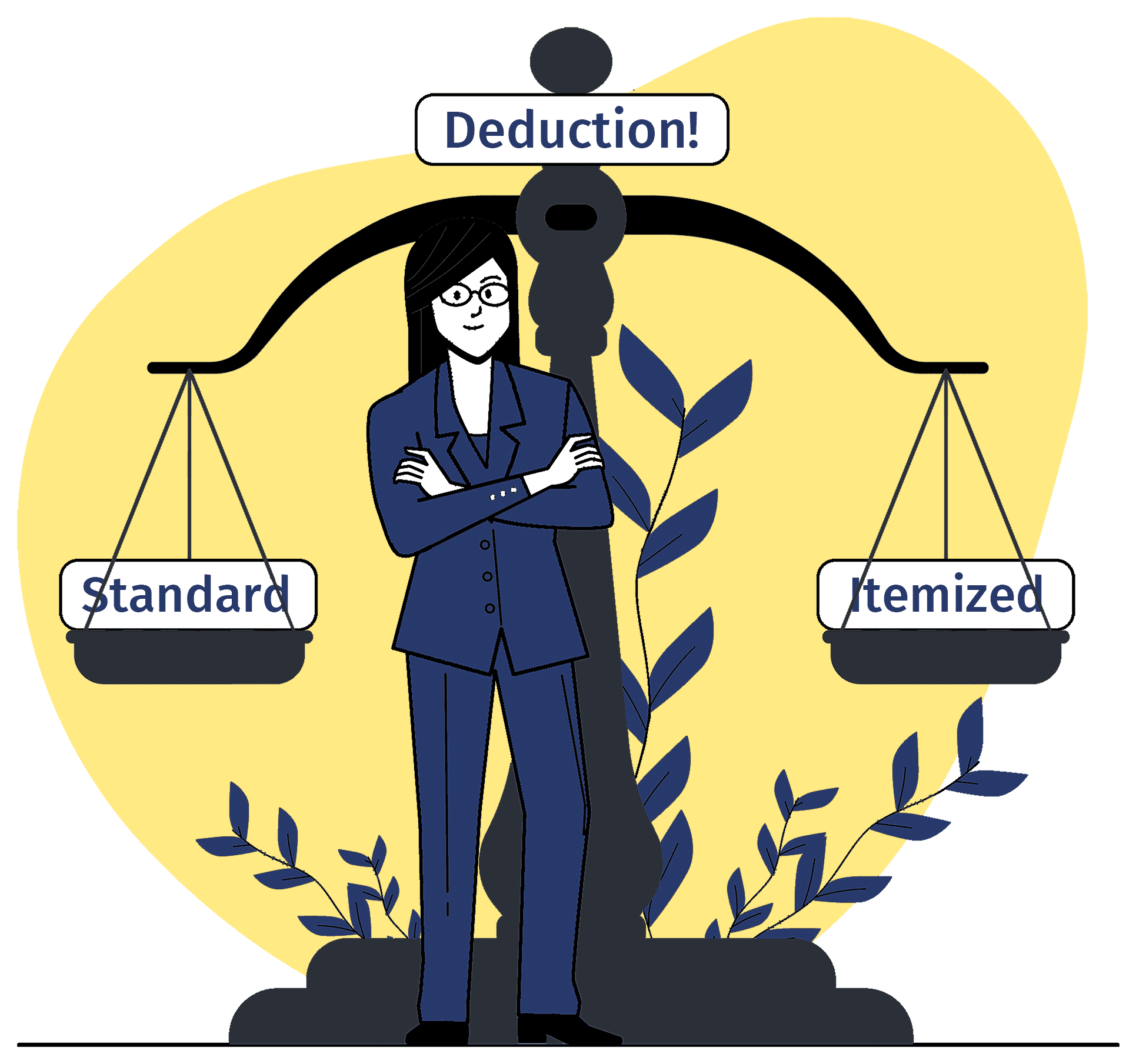Itemize Deduction or Standard Deduction?
Whether to apply the standard deduction or itemized deduction method on a tax return is simple in recent years as the standard amount is usually larger than itemizing. If the standard deduction amount for your filing status is greater than your total itemized deductions, then you should take the standard deduction. Otherwise, you should claim itemized deductions on your tax return.

It Is Better to Take the Standard Deduction or Itemize?
To decide between the standard deduction and itemized deductions, compare the amounts. If your itemized deductions (like medical expenses, mortgage interest, and charitable donations) total more than the standard deduction, itemizing is better. If not, the standard deduction is simpler and more beneficial. You can also use tax filing software like eFile.com which can help you with calculating and recommending the best option based on your financial details.
KEY TAKEAWAYS
- The standard deduction is a fixed amount that varies by filing status, age, and inflation. It's simpler to claim than itemized deductions and often benefits many taxpayers.
- Itemized deductions include specific expenses such as medical bills, mortgage interest, charitable donations, and state/local taxes. These can be more beneficial if they exceed the standard deduction and are listed on Schedule A.
- To determine whether to take the standard deduction or itemize, compare the total of your itemized deductions with the standard deduction amount for your filing status and use the one that saves you the most money.
- You must choose between the standard deduction and itemized deductions on your tax return; you can't use both methods in the same year.

Is It Worth Itemizing Deductions?
Deciding whether to claim the standard deduction or itemize deductions depends on your specific financial situation. Here’s a simple example to help you determine which option might be better for you:
1. Compare Deductions
- Standard Deduction: check the standard deduction for 2024 year.
- Itemized Deductions: This includes deductions for:
- State and local taxes (SALT) up to $10,000
- Mortgage interest
- Charitable contributions
- Medical and dental expenses (subject to a 7.5% AGI floor)
- Casualty and theft losses.
2. Evaluate Your Expenses
Calculate your total itemized deductions and compare it to the standard deduction.
- List Your Itemized Deductions: Add up all your deductible expenses, including mortgage interest, property taxes, charitable donations, medical expenses, and any other qualifying deductions.
- Simply enter all your itemized deductions into your eFile account and the total will be calculated for you.
- Compare: If the total of your itemized deductions is greater than the standard deduction amount for your filing status, itemizing will generally result in a larger deduction and lower taxable income.
eFile works for you by doing this comparison and selecting the best method.
Let's look at an example:
- Filing Status: Single
- Itemized Deductions:
- Mortgage Interest: $6,000
- Property Taxes: $4,500
- Charitable Donations: $1,200
- Medical Expenses: $1,000
- Total Itemized Deductions: $6,000 + $4,500 + $1,200 + $1,000 = $12,700.
Comparison:
In this case, the standard deduction is higher than the total itemized deductions of $12,700, so it would be more beneficial to claim the standard deduction. For most people, the standard deduction is simpler and provides a larger benefit, but if you have substantial itemized deductions, itemizing could result in a lower tax bill.
What Is the IRS Standard Deduction?
The standard deduction is a dollar amount that directly reduces your taxable income since it is not subject to tax, thus reducing your tax bill. The standard deduction amounts for any given tax year are based on filing status and age and are updated each year for inflation; see the current standard deduction dollar amounts.
The standard deduction is often the better and more common choice since you do not need to add up expenses to claim it. You can start your return on eFile.com and see the actual results based on your personal tax situation.
You cannot claim the standard deduction if any of the following situations apply to you:
- You claim itemized deductions or you are filing as married filing separately and your spouse itemizes (you must both either itemize or claim the standard deduction).
- You are a nonresident alien, dual–status alien, or an individual who files tax returns for periods of less than 12 months.
- You are claimed as a dependent.
Related: Calculate your income tax bracket based on your income and filing status.
You can still claim above-the-line deductions while still claiming the standard deduction. This includes expenses such as educator expenses and the student loan interest deduction.
You may ask yourself:
How do I know if I need to file? Do I need to file if I make less than $5,000? $10,000? Should I file if I make less than the standard deduction?
- Use this free tax tool to determine if you need to or may want to file a tax return.
- You should file a tax return if you make more than the standard deduction for your filing status.
- If you have taxable income with taxes withheld via Form W-2, you should always file a return.
Get all the details on the standard deduction page or review the IRS publication on deduction methods.
If you are still not sure which tax deduction to use on your tax return, eFile.com can make this easy for you. When you prepare your tax return on eFile.com, based on the information you provide, we will calculate your standard deduction amount.
What Are Itemized Deductions?
Itemized deductions are claimed via Schedule A and Form 1040 - eFileIT - based on qualifying expenses that you made during the year that the IRS considers to be tax deductible. These include:
Itemized deductions reduce your taxable income by a dollar amount. You should itemize if the total amount of your itemized deductions is more than your standard deduction amount - eFile will determine this for you.
There is no limitation on itemized deductions based on your adjusted gross income. However, there are other limitations that may affect the contents of your Schedule A, such as state and local taxes (SALT) which is limited to $10,000.
Itemizing your deductions does not include deducting expenses directly related to your business or rental income expenses; you can also make adjustments to income in addition. These are reported separately on Schedule 1 (income adjustments), Schedule C (self-employment), and Schedule E (rental) - eFile.com will help you will in these forms and e-file them with your return.
See a full list of IRS forms and schedules, such as Schedule A, that may be helpful when filing your taxes. Check out more tax deductions you may qualify to claim on your tax return and don't overlook eligible tax credits.
TurboTax® is a registered trademark of Intuit, Inc.
H&R Block® is a registered trademark of HRB Innovations, Inc.